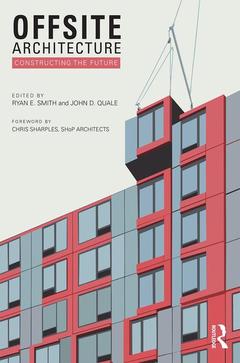Description
Offsite Architecture
Constructing the future
Coordinators: Smith Ryan E., Quale John D.
Language: English
Subject for Offsite Architecture:
Keywords
UK’s Devolve Administration; quale; UK Supply Chain; prefabrication; Recreational Vehicle; prefab; Checker Board; design; Construction Management Faculty; engineering; Integrated Product Delivery; manufacturing; Cross-laminated Timber; offsite; Sekisui House; offsite architecture; Daiwa House; offsite construction; Modular Industry; Ryan E; Smith; System Structure Model; offsite prefabrication; Industrialized Building Systems; theory; Offsite Fabrication; practice; Bathroom Pods; construction; Modular Companies; Edinburgh Napier University; Housing Delivery System; Light Wood Frame; McGraw Hill Construction; PH Standard; Modular Housing; Asahi Kasei; Construction Management Programs; Multi-unit Housing; Onsite Construction
Publication date: 03-2017
· 15.6x23.4 cm · Hardback
Publication date: 03-2017
· 15.6x23.4 cm · Paperback
Description
/li>Contents
/li>Readership
/li>Biography
/li>
Architects have been intrigued by prefabricated construction since the early twentieth century. Recent advances in design, engineering and manufacturing processes have led to a significant expansion in the use of pre-assembled components, which are fitted to finished structures on site. Collectively, such processes are becoming known as "offsite construction."
A ground-breaking text, Offsite Architecture establishes the current ? and future ? state of thinking in this field. A range of the most highly regarded thinkers and practitioners from around the globe share their ideas and practical findings on offsite prefabrication, examining theory and practice, opportunities and challenges, successes and failures.
A timely response to the growing interest in this method, the book provides the fundamental basis for a critical, reflective approach to offsite architecture. Contributions from both academics and professionals make Offsite Architecture required reading for practitioners as well as students taking courses in architecture, prefabrication, construction and engineering.
Foreword Chris Sharples Introduction Ryan E. Smith and John Quale Part 1: Offsite Theory 1. Industrialized Building System Categorization Roger-Bruno Richard 2. System Structures: Theory of Industrialized Architecture Kasper Sánchez Vibæk 3. Constructing Dialogues: On Architectural Potentials of Montage Charlotte Bundgaard 4. Industrial Relevancy Today: Suggestions for Offsite Construction Industry’s Future Trends Marjorie P. Callahan 5. Mapping the Modular Industry Ivan Rupnik 6. Prefabricated Housing in Architectural Culture Mathew Aitchison and John MacarthurPart 2: Offsite Practices 7. Offsite Construction Industry Meta-Analysis: Industry Survey Results Talbot Rice and Ryan E. Smith 8. Permanent Modular Construction: Construction Performance Ryan E. Smith and Talbot Rice 9. Off-site Construction in Education: a survey of prefabrication in design and construction academics Ryan E. Smith, Jon Elliott, and Kevin Grosskopf 10. Onsite vs. Offsite: Comparing Environmental Impacts John Quale 11. High Performance Affordable Modular Homes: A University and Modular Industry Collaboration John Quale 12. A Case Study of Multi-Trade Near-Site Factory Assembly Kihong Ku and Paul Broadstone 13. Prefabricated Housing In Japan Dana Buntrock 14. Offsite Construction in Sweden: from Technology to Integrated Process Helena Lidelöw 15. A Scottish Perspective on Timber Offsite Construction Robert Hairstans and Fausto Sanna List of Illustration Credits Glossary of Terms Index
Ryan E. Smith is an Associate Professor of Architecture at the University of Utah, USA. He has investigated offsite design and construction for nearly a decade through industry-applied research. He is author of Prefab Architecture (Wiley, 2010) and Building Systems (Routledge, 2012). He is past Chair of the Board of Directors of the National Institute of Building Sciences Off-Site Construction Council. He is a Senior Research Fellow at the Centre for Offsite Construction at Edinburgh Napier University in the UK.
John D. Quale is Director and Professor of Architecture at the University of New Mexico School of Architecture and Planning, USA. His expertise is in sustainable design, affordable housing, prefabrication, the environmental impact of construction, and collaborative and integrated design processes. He is the author of Sustainable, Affordable, Prefab: The ecoMOD Project (UVA Press, 2012) and Trojan Goat: A Self-Sufficient House (UVA Press, 2002), about his leadership of the 2002 UVA Solar Decathlon Team in a national design/build house competition sponsored by the US Department of Energy.




